
views
Preparing to Grow Marigolds

Determine what growing zone you live in. The USDA has defined 13 growing zones for the United States, ranging from the extremely cold Zone 1 (in far-north Alaska) to the extremely warm Zone 13 (in parts of Hawaii and Puerto Rico). Most of the country ranges from Zone 3 to Zone 10. Marigolds are annual plants in most zones, meaning they will die in the winter and will not return the next growing season. Marigolds are hardy, self-seeding flowers. If you live in Zone 8 or higher, your marigolds may not die off during the winter and will probably return with fuller vigour the following spring.

Know when to plant your marigolds. Although marigolds are a very hardy plant, they can die in cold weather. Plant marigolds after the last frost. American (African) marigolds should be planted immediately after the last frost because they are slow to mature. If possible, plant your marigolds on a cloudy day or in the morning; this will help prevent further transplant shock to the plants from the heat.

Decide whether you will use seeds or seedlings. Seeds will take a few weeks to germinate but cost much less. Seedlings or plants bought from a gardening store will give you immediate satisfaction but are more expensive. While it's not necessary, you can start the seeds indoors 4-6 weeks before you want to plant them outside. Marigolds can also be directly seeded into the ground outdoors when the soil temperatures reach 60 to 80 degrees Fahrenheit ( Late May to Mid June) as well. Short varieties such as the French Marigolds germinate quickly and flower very fast within few weeks after planting. If you use seedlings or plants, you can plant them as soon as the last frost is gone.

Determine where you will grow your marigolds. Marigolds grow well both in flowerbeds and in pots and other containers, but they need space to spread out. Fully grown marigold plants in beds should be spaced 2 to 3 feet (0.61 to 0.91 m) apart so that they can get enough sunlight. Marigolds perform best in full sunlight, although they can handle up to 20% shade. Do not plant them in a fully shaded area, as they will not thrive. Marigolds are tolerant of dry, sandy soil, but they do not grow well in overly damp soil. Make sure your beds or containers have adequate drainage; you can add a layer of gravel to the bottom and cover it with soil before planting to enhance draining.

Decide what size marigold you want to grow. There are four main groups of marigold species, and each of them produce variations in color and size. This varies greatly on the cultivar or variety you grow. You can always get size info on the package of seeds itself or looking it up on the web. African marigolds Tagetes erecta come in two basic varieties: “large-flowered” and “tall.” Large-flowered African marigolds are fairly short, at between 12-14” tall, but as the name suggests have very large blossoms (up to 3.5” inches in diameter). Tall African marigolds have small flowers but can grow up to 3’ tall. Both almost always produce orange or yellow flowers. African marigolds may also be referred to as “American” marigolds. French marigolds Tagetes patula come in two basic varieties: “large-flowered” and “dwarf.” Large-flowered French marigolds are between 12-16” tall with large (up to 2”) flower blossoms. Dwarf French marigolds rarely grow higher than 12” and produce small flowers. French marigolds come in varieties of yellow, gold, and orange. Triploid marigolds are a hybrid of French and African marigolds and are also sometimes known as “mule” marigolds because they cannot reproduce. They grow fairly tall and produce large (up to 2”) flowers. Single marigolds are also known as signet marigolds Tagetes tenuifolia. They are quite different in appearance from other marigold varieties because their flowers have very simple, almost daisy-like flowers rather than the thick, bushy blossoms of most other marigold types also these varieties are more wild looking.
Starting Marigolds from Seed

Purchase seeds. Seed packets can range in price anywhere from 10 cents to a dollar or more per pack, depending on the breed. You can purchase seeds from garden supply centers, superstores, and online retailers. French marigolds start from seed much faster than African marigolds. Hybrid varieties will not usually start from seed. If you have leftover seeds, you can save them for the following growing season. Seal them in an air-tight container such as a mason jar in a cool, dry place.

Use a divided seed planter to start your seeds. It’s best to use a divided seed container so that you can easily separate the roots of your seedlings once they’ve begun to grow. You can purchase these at most gardening stores. You can also use an egg carton filled with potting mix to start your seeds.

Fill the seed planter with potting mix or seed starting mix. It is preferable to use a nutrient-enriched soil or mix when starting seeds, rather than straight topsoil, as it will give the seeds an extra nutritional boost and make it easy for young roots to take hold.
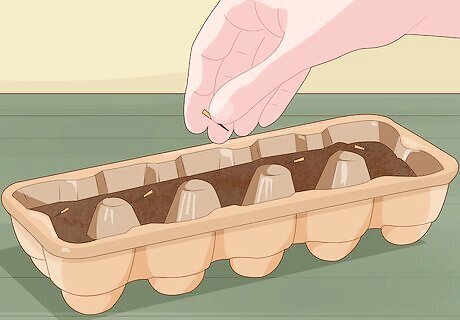
Sow the seeds in the soil. Refer to the package directions for the appropriate planting depth, as this will vary by marigold breed. Avoid sowing more than 2 seeds in the same division of your seed planter; sowing too many seeds in the same spot will force them to fight for sunlight and oxygen and will prevent rapid growth.
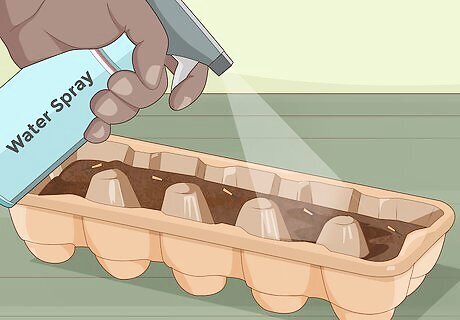
Moisten the soil daily using a spray bottle. Watering newly sown seeds with a watering can could simply wash the seeds away. Use a spray bottle filled with clean water to mist the soil until it’s damp.

Thin the seedlings when they reach 2” tall. Use a spoon or other small tool to dig the seedling out of the planter, being careful not to damage the roots. Remove any dead or browning seedlings.
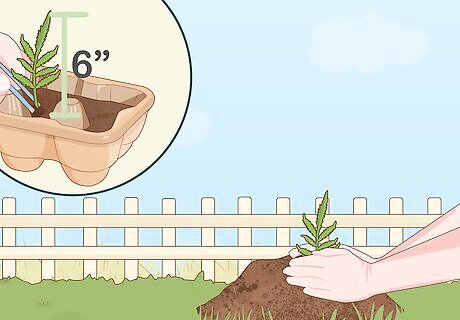
Transplant marigolds once they’ve reached 6” tall. Transplant marigolds into your garden beds or containers when they’re about 6” tall and look fairly sturdy. Handle the plants with care so as not to damage the roots.
Planting Your Marigolds
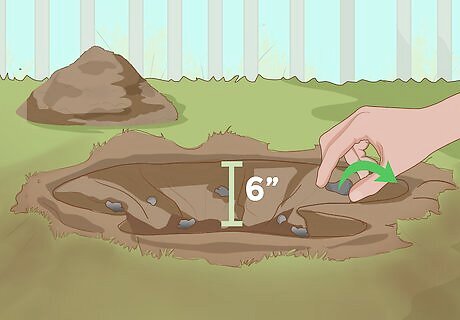
Loosen the soil by digging to a minimum depth of 6”. Use a hand aerating tool, a hoe, or even your hands to break up large clods of soil and make sure it is aerated so that oxygen can reach the roots of your plants. Remove any sticks, stones, or debris from the soil. These will hinder root growth.

Dig a shallow hole for planting. The root ball of the marigold plant should be able to fit into the hole while the leaves remain above ground.

Place the plant in the hole. Cover the root ball with soil and pat firmly in place. Use a watering can to water the plant at the base, watering until the soil is moist but not flooded.
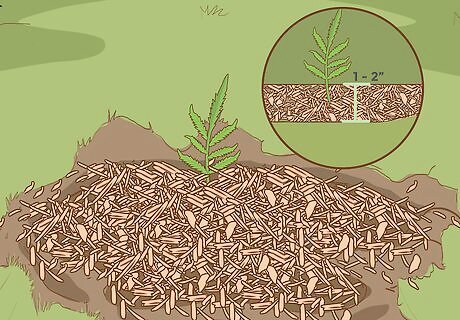
Prevent weeds with mulch. Spreading a 1-2” layer of mulch, pine bark, or other organic material on your beds between marigold plants will help prevent weeds from growing. It will also help the soil retain moisture, meaning you don’t have to water as often.

Fertilize the soil. Most fertilizers available for home use contain three basic nutrients essential for plant growth: nitrogen, phosphorus, and potassium. The three numbers on packaged fertilizer reflect the concentrations of each nutrient. Marigolds thrive on a 20-10-20 (20% nitrogen, 10% phosphorus, and 20% potassium) fertilizer. Don’t over-fertilize the soil or it will actually damage your marigolds. Fertilizing once every two weeks is plenty. It's also a good idea to dilute your fertilizer more than the package recommends. In place of fertilizer, you can use compost instead.
Cultivating Your Marigolds
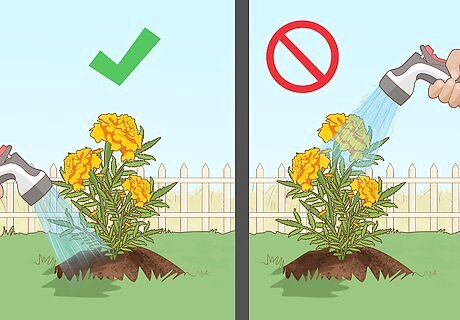
Water your marigolds at the bottom, not from the top. Pouring water over the marigold blossoms and leaves may damage or even rot them. Instead, use a watering can to water your flowers at the base of the plants. Try to avoid using a garden hose to water your plants. The force of the water may wash away the top layer of soil.
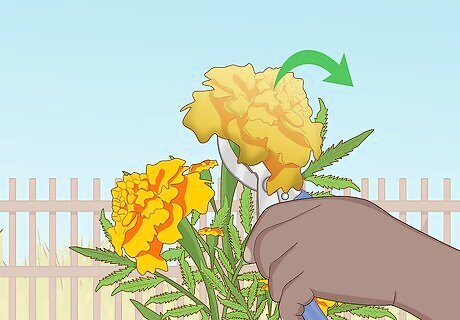
Deadhead your marigolds. “Deadheading” is a cultivating process in which you snip off dead blossoms from flowering plants. While not strictly necessary, deadheading your marigolds will help prompt the plant to produce new flowers. To keep marigolds compact, pinch off new, unwanted growth.

Use insecticidal soap to prevent infestation. Although marigolds are very hardy, they may sometimes have pest problems. A mild solution of insecticidal soap, which is sold at most gardening supply stores and even supermarkets, will help keep pests at bay without presenting a toxic hazard. Some marigold species are edible. If you use marigolds in any edible preparation, wash them thoroughly first to remove any insecticidal soap residue. Do not eat marigolds that have had chemical pesticides sprayed on them.

Stake your flowers, if necessary. Most marigold species grow quite close to the ground, but if you’ve chosen a taller variety such as the African marigold, you may need to provide a stake to support the stalk. Use stakes about 2’ high and tie the plant to the stake with a soft, stretchy fabric. (Old nylon stockings work very well for this!)

















Comments
0 comment